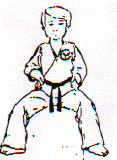 Body weight should be distributed 50% on each leg. Lefs should be spread shoulder width apart and the knees should be bowed outward so as to strengthen the stance. This is a side fighting stance, 75% defense and 25% offense. The feet shyoould be pointing straight or at a slightly outward angle in front of the body and the hips should be tucked in so they are in line with the heels. The knees should be bent so they will allow slight viewing of the toes.
Body weight should be distributed 50% on each leg. Lefs should be spread shoulder width apart and the knees should be bowed outward so as to strengthen the stance. This is a side fighting stance, 75% defense and 25% offense. The feet shyoould be pointing straight or at a slightly outward angle in front of the body and the hips should be tucked in so they are in line with the heels. The knees should be bent so they will allow slight viewing of the toes.
Body weight should be 60% on the front leg an 40% on the back leg. The front leg is bent so that the knee is straight above the ankle and the front foot is pointing straight ahead. The back foor is to be pointing at about a 30 to 40 degree angle. The knee of the back leg should be straight, but, not locked into position. This is a front fighting stance and should be accompainied with the forward leg block. This stance is 50% offense and 50% defense.
Body weight should be distributed 90% on the back leg an 10% on the front leg. The back leg is to be in a somewhat crouched position with the back foot turned to a slight angle in order to support the body weight. The front leg is bent with only the ball of the front foot touching the floor. The front foot is approximately 1 1/2 to 2 foot lengths from the ball of the back foot. This stance is 75% offense and 25% defense.


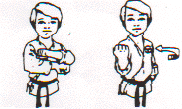
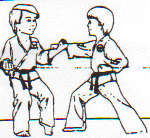
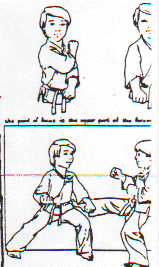 This block can be done from any of the hree stances, but, most usually from a Senkutsu-Dachi or Hachiji-Dachi. The blocking arm crosses down in front of the body form the opposite shoulder of the blocking hand to a point 1 to 1 1/2 widths above the bocking side leg or knee. The last part of the blocking motion should be a popping action with the arm that is a blocking extending slightly beyond the side of the body and then returning to a postion of evenness with the side of the body.
This block can be done from any of the hree stances, but, most usually from a Senkutsu-Dachi or Hachiji-Dachi. The blocking arm crosses down in front of the body form the opposite shoulder of the blocking hand to a point 1 to 1 1/2 widths above the bocking side leg or knee. The last part of the blocking motion should be a popping action with the arm that is a blocking extending slightly beyond the side of the body and then returning to a postion of evenness with the side of the body.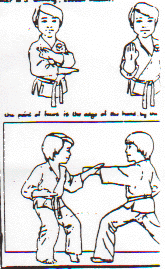 Most commonly this block is performed from the Neko-Ashi-Dachi stance, but, can be done form any of the three stances. This block is performed with the Shuto hand position. THe blocking starts with the blocking hand moving to the opposite side shoulder and then extending in a slight circle or arching motion with the palm facing outward toward the striking force. THe opposite hand and arm should be brought back into the ready position with the palm facing upward.
Most commonly this block is performed from the Neko-Ashi-Dachi stance, but, can be done form any of the three stances. This block is performed with the Shuto hand position. THe blocking starts with the blocking hand moving to the opposite side shoulder and then extending in a slight circle or arching motion with the palm facing outward toward the striking force. THe opposite hand and arm should be brought back into the ready position with the palm facing upward.
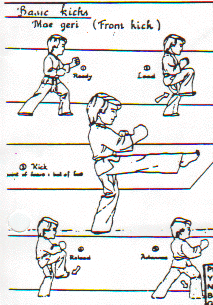 The kicking leg should be raised until the knee is slightly higher than the point of the target. The other leg should be slightly bent to allow for stability and balance of the body on this leg. The ball of the foot on the kicking leg should be extended as far forward as possible. Bending at the ankle, thus locking the ankle joint and making it strong - with the toes curled back. All of this development should be done by the time the leg/ankle/foot is raising off the floor. If kicking with the back leg, this should be done when the kicking leg passes the other (support) leg. This kick can be used at three different levels; High, Middle, Low. This kick can be done in two different ways: Snapping; to emphasize speed and a popping action upon the target, and: Thru~LllwI so as to emphasize speed and a powerful thrusting upon the target. This kick can be done from any of the stances.
The kicking leg should be raised until the knee is slightly higher than the point of the target. The other leg should be slightly bent to allow for stability and balance of the body on this leg. The ball of the foot on the kicking leg should be extended as far forward as possible. Bending at the ankle, thus locking the ankle joint and making it strong - with the toes curled back. All of this development should be done by the time the leg/ankle/foot is raising off the floor. If kicking with the back leg, this should be done when the kicking leg passes the other (support) leg. This kick can be used at three different levels; High, Middle, Low. This kick can be done in two different ways: Snapping; to emphasize speed and a popping action upon the target, and: Thru~LllwI so as to emphasize speed and a powerful thrusting upon the target. This kick can be done from any of the stances.
 This kick can be done from any stance. Body weight is shifted from one leg to the other. Either by bodyshifting or by a stepping movement. The kicking leg is raised to the side, if done from Hachiji-Dachi, or to the front, if done from Zenkutsu-Dachi with the knee of the kicking leg facing or pointing toward the target. In this raised position, the foot position and ankle position should be completed. As the leg is extended to the target, the hips are to be thrusted. Not Rolled. into the movement of the kicking leg. The upper part of the body is to be planed out horizontally to the floor. The point of contact on the kicking foot is the heel in the thrust kick and the edge of the foot in the snapping kick.
This kick can be done from any stance. Body weight is shifted from one leg to the other. Either by bodyshifting or by a stepping movement. The kicking leg is raised to the side, if done from Hachiji-Dachi, or to the front, if done from Zenkutsu-Dachi with the knee of the kicking leg facing or pointing toward the target. In this raised position, the foot position and ankle position should be completed. As the leg is extended to the target, the hips are to be thrusted. Not Rolled. into the movement of the kicking leg. The upper part of the body is to be planed out horizontally to the floor. The point of contact on the kicking foot is the heel in the thrust kick and the edge of the foot in the snapping kick.